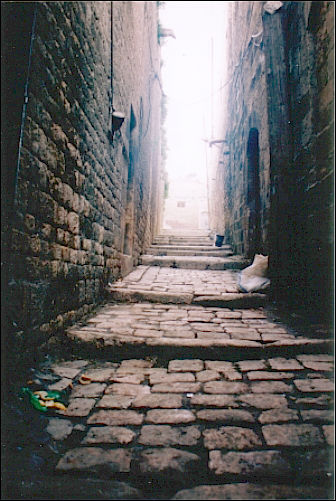



Aleppo has exceptional universal value because it represents medieval Arab architectural styles that are rare and authentic, in traditional human habitats. It constitutes typical testimony of the city's cultural, social, and technological development, representing continuous and prosperous commercial activity from the Mameluke period. It contains vestiges of Arab resistance against the Crusaders, but there is also the imprint of Byzantine, Roman and Greek occupation in the streets and in the plan of the city.
Located 350 km north of Damascus at the crossroads of several trade routes, Aleppo was very prosperous from the 3rd millennium BC, a prosperity it preserved throughout its evolution and its settlement. The old city was surrounded by a defensive enclosure, flanked by towers and entered by fortified gates from the Islamic era. Aleppo is famous for its mosques, madrasas (the Fardos Madrassa is one of the outstanding religious buildings) and churches. It is still a very active Arab commercial city. Aleppo has a jumble of houses in the subtlest pastel colours with slender minarets and, dominating it all, the great mass of the Citadel. The southern ramparts, partly cleared of houses, lead to the impressive of all the fortified gates, Bab Qinnesrin.
The al Gassa- skirts the Jdeideh, 'old houses' quarter, with its beautifully decorated courtyards. All the houses here are built from fine limestone, lining narrow streets without shops and sometime vaulted. This lead through the souks, covered by vaulted roofs. The al Joumrok khan (Customs Caravanserai) dates from the 17th century: French, English, and Dutch merchants traded here and their consuls were obliged to live here. In a corner a staircase leads up to a private house which was the Venetian consulate from the 15th to the 19th century when it became the residence of the Belgian consul; at the present time the house conserves its typically Venetian style. Over many generations men of taste have built up a priceless collection of works of art from every country between China and.
The Jami al Kabir entrance (Umayyad or Great Mosque) is opposite an old Koranic school, the al Halawyah Madrassa, installed in the former Byzantine cathedral erected at the command of the Empress Helena. The Great Mosque was founded in the early Islamic period, but there is little to see that dates from that time. The Mameluke minaret dates from 1090 and is, with its fine proportions and Kufic inscriptions, a good example of the great period of Islamic architecture in Syria. The north facade is one side of the square.
A ring of crenellated walls and towers rises rise 50m above the city from a steep glacis, encircling a mass of ruins of every period. The nail-heads on the doors themselves are beautifully worked, the lintels have comic or enigmatic carvings on them, and there are fine Kufic inscriptions calling upon the power and the mercy of Allah. The interior of the citadel shows all too clearly how it has been ravaged by enemies (the Mongols invaded it twice) and shattered by earthquakes (that of 1822 was particularly devastating).
St George's Cathedral stands behind a labyrinth of narrow streets on a tiny square. The postern gate in the middle of the ramparts (Bab Antakia) is the Antioch Gate. Beyond there are many important monuments - the little domed Byzantine church converted into a mosque; a prison with dungeons dug into the rock; a stretch of wall 4 m thick, the base of a Syrio-Hittite temple; the remains of a great mosque built by Saladin's son; a covered building containing sculpture and objects from various periods found on the site; the tomb of Emir Zaher Ghazi (son of Saladin) in an annex to a madrasa founded during the Crusader period.





0 komentar:
Posting Komentar